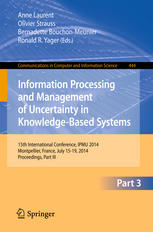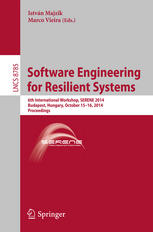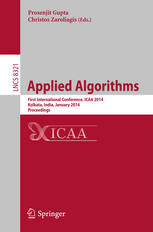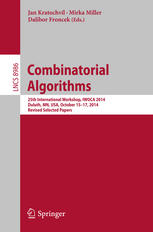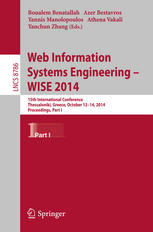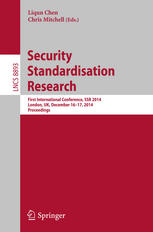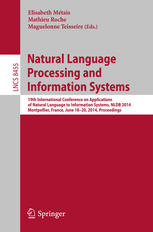Information Systems for Crisis Response and Management in Mediterranean Countries First International Conference ISCRAM med 2014 Toulouse France October 15 17 2014 Proceedings 1st Edition by Chihab Hanachi, Frédérick Bénaben, François Charoy 3319118185 9783319118185
$50.00 Original price was: $50.00.$25.00Current price is: $25.00.
Information Systems for Crisis Response and Management in Mediterranean Countries First International Conference ISCRAM med 2014 Toulouse France October 15 17 2014 Proceedings 1st Edition by Chihab Hanachi, Frédérick Bénaben, François Charoy – Ebook PDF Instant Download/DeliveryISBN: 3319118185, 9783319118185
Full download Information Systems for Crisis Response and Management in Mediterranean Countries First International Conference ISCRAM med 2014 Toulouse France October 15 17 2014 Proceedings 1st Edition after payment.
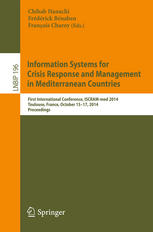
Product details:
ISBN-10 : 3319118185
ISBN-13 : 9783319118185
Author: Chihab Hanachi, Frédérick Bénaben, François Charoy
This book contains the refereed proceedings of the First International Conference on Information Systems for Crisis Response and Management in Mediterranean Countries, ISCRAM-med 2014, held in Toulouse, France, in October 2014. The aim of ISCRAM-med was to gather researchers and practitioners working in the area of Information Systems for Crisis Response and Management, with a special but not limited focus on Mediterranean crises. These include political crises, economic crises, natural hazards, and fatal industrial incidents. The 15 full papers included in this book were carefully reviewed and selected from 44 submissions. The contributions are organized in topical sections on supply chain and distribution; modeling and training; human interactions in the crisis field; coordination and agility; and social aspects in crisis management.
Information Systems for Crisis Response and Management in Mediterranean Countries First International Conference ISCRAM med 2014 Toulouse France October 15 17 2014 Proceedings 1st Table of contents:
A Location-Allocation Model for More Consistent Humanitarian Supply Chains
1 Introduction
2 Background
3 Modeling Principles
4 The Mixed Integer Stochastic Program
5 Case Study
5.1 Context
5.2 Scenario Definition
5.3 Model Execution
6 Conclusions and Future Works
References
Towards Large-Scale Cloud-Based Emergency Management Simulation “SimGenis Revisited”
1 Introduction
2 Related Work
3 From SimGenis to LC2SimGenis : Reuse for Deployment and Interfacing
3.1 Target Cloud Environments and SimGenis
3.2 Deployment Approach: SimGenis as a Service on Amazon EC2
4 Experimentation
4.1 Scenarios and Configurations
4.2 First Results
4.3 Collaborative Data Analysis and Visualization
5 Discussion and Conclusion
References
Modeling and Training
Approaches to Optimize Local Evacuation Maps for Helping Evacuation in Case of Tsunami
1 Introduction
2 Related Work
2.1 Optimization of Sign Placement for Tsunami Evacuation
2.2 Estimating Number of Survivors by Agent-Based Simulation
2.3 Evaluating Casualties by Linear Programming Formulation
3 Formalization of the Optimization Problem
3.1 Fitness Evaluation by Agent-Based Simulation
3.2 Fitness Evaluation by Linear Programming Formulation ofCasualties Evaluation of Pedestrian Evacu
4 Implementation and Evaluation
4.1 Description of Application Case
4.2 Evaluation
5 Conclusion
References
EDIT: A Methodology for the Treatment of Non-authoritative Data in the Reconstruction of Disaster Sc
1 Introduction
2 Mapping for Crisis
2.1 Advantages and Disadvantages of Non-authoritative Data Usage
3 EDIT
3.1 Related Work
3.2 Disaster Ontology Definition
3.3 Concept Map
3.4 Database Creation
3.5 Natural Language Processing
3.6 Twitter
3.7 Semantic Reliability Index
4 Application to Two Case Studies
5 Conclusion
References
Towards a Decision Support System for Security Analysis
1 Introduction
2 Formalization of an Accident Scenario
2.1 Notion of an Accident Case
2.2 Case Model
3 Proposed Approach
3.1 General Description of the Approach
3.2 Proposed Decision Support System
3.3 Experiments
4 Conclusion
References
Crisis Mobility of Pedestrians: From Survey to Modelling, Lessons from Lebanon and Argentina
1 Introduction and Background
1.1 Objectives
1.2 State of the Art
1.3 Methodology
2 The AMEL Model
2.1 Description of the Model
2.2 Simulation
2.3 Simulation Scenarios
2.4 Some Results
2.5 Model Enhancement
3 The Argentinian Survey
3.1 The VUSIM Project
3.2 The Survey
3.3 Model Methodology: From Two Case Studies to One Generic Model
4 Conclusion
References
Supporting Debriefing with Sensor Data: A Reflective Approach to Crisis Training
1 Introduction
2 Theoretical Underpinning
3 Different Forms of Debriefing
3.1 Scenario of Use 1
3.2 Scenario of Use 2
3.3 Comparing the Two Scenarios
4 WATCHiT: Collecting Data from the Field
5 CroMAR: Supporting in Situ Debriefing on Complex Events
5.1 System Description
5.2 Evaluation
6 Procedure Trainer: Supporting Debriefing on Short Medical Procedures
6.1 System Description
6.2 Evaluation
7 Lessons Learned
8 Conclusions and Future Work
References
Human Interactions in the Crisis Field
Citizen Participation and Social Technologies: Exploring the Perspective of Emergency Organizations
1 Introduction
2 The Role of Social Technologies in EM
3 Citizen Participation: A Study to Explore the Perception of EM Organizations
3.1 First Study: Social Media and EM
3.2 Second Study: Analysing Current and Future Citizen Participation
3.3 Discussion
4 Identifying Ecologies of Participants in EM
5 Conclusions
References
Access Control Privileges Management for Risk Areas
1 Introduction
2 Related Work
3 Risk and Access Control: Concepts
3.1 Risks and Access Control: Monitored Environment
3.2 Fundamentals of a Risk Management System (
4 Adaptive Access Control: Considering Risks and Disasters
4.1 Dynamic Access Control Model
4.2 Adaptive Access Control
5 Conclusions and Future Works
References
A Formal Modeling Approach for Emergency Crisis Response in Health during Catastrophic Situation*
1 Introduction
2 Related Work
3 Architecture
4 Component Behaviors
5 Properties
5.1 Informal Description
5.2 LTL Description
6 Properties Verification
7 Conclusion
References
Collaborative Re-orderings in Humanitarian Aid Networks
1 Introduction
2 Literature Positioning
2.1 Collaboration and Disaster Response Literature
2.2 Collaboration and Information Systems and Organisation Studies Literature
3 STS and Practice Theory Studies
4 Methods
5 Collaborative Re-orderings in Humanitarian Networks: Reconfiguring and Fusing
5.1 Humanitarian Aid Networks Facing Opportunities and Challenges
5.2 Reconfiguring the Traditional Humanitarian Networks
5.3 Reconfiguring the VTC Networks
5.4 Fusing Practices and Mechanisms
6 Discussion and Conclusion
References
Coordination and Agility
Towards Better Coordination of Rescue Teams in Crisis Situations:A Promising ACO Algorithm
1 Introduction
2 Related Work
2.1 Criticisms on Statistical Approaches
2.2 Combinatorial Optimization
3 The Proposed Approach
3.1 Goals
3.2 Data Structure
3.3 Ant Colony Optimization (ACO) for Multi-goal Optimization Problems
3.4 Algorithm
3.5 Example Scenario
4 Conclusion and Perspectives
References
A Multi-agent Organizational Model for a Snow Storm Crisis Management
1 Introduction
2 A Multi-agent Organizational Model for Snow Storm Crisis Management
2.1 Case Study: Heavy Snow Storm Crisis
2.2 Conceptual Modeling of the Environment
2.3 Role Model
2.4 Interaction Model
3 A Multi-agent Organizational Snow Storm Management Simulator
4 Conclusion
References
Agility of Crisis Response: From Adaptation to Forecast: Application to a French Road Crisis Managem
1 Introduction
2 Agility and Forecasts
3 Mechanisms of Agility
3.1 Modelling the Crisis Situation
3.2 Detect the Mismatch
3.3 Suggest Adaptation Solutions
4 Anticipating the Future
5 Road Crisis Use Case
6 Conclusion
References
The Dewetra Platform: A Multi-perspective Architecture for Risk Management during Emergencies
1 Introduction
2 Description of the Structure and Usage of the System
2.1 Static Layers
2.2 Dynamic Layers
2.3 Operational Tools
3 Case Study n.1: Designing a Synthetic Risk Scenario
3.1 October 25th, 2001: The Event in Nutshell
3.2 The Assessment of Potential Hazard
3.3 The Estimation of the Vulnerability
3.4 The Exposures
4 Case Study n.2: A Contribution to the Emergency Management
4.1 May, 2012: The Event in Nutshell
4.2 The Emergency Resources Management
4.3 The Analysis of Residual Risk
5 Conclusion
References
Decision Support for Disaster Risk Management: Integrating Vulnerabilities into Early-Warning Syste
1 Introduction
2 Decision Support for Risk Management
2.1 Managing Disaster Risks
2.2 Vulnerability Assessment in for Decision Support in Disaster Management
2.3 Early-Warning Systems
3 Indicators
3.1 Indicators for Vulnerability Assessment
3.2 Indicators for Early-Warning Systems
4 Integrating Vulnerability into Early-Warning Systems
4.1 Risk Knowledge
4.2 Monitoring and Warning
4.3 Dissemination, Communication, and Response Capability
5 Conclusion and Perspectives
References
Social Aspects in Crisis Management
Integration of Emotion in Evacuation Simulation
1 Introduction
2 Related Work
3 Simulation Description
3.1 Emotion Modeling
3.2 Behavior of Human Agent
4 Experiments
4.1 Scenarios
4.2 Experimental Results and Evaluation
5 Conclusion
References
Emotional Agent Model for Simulating and Studying the Impact of Emotions on the Behaviors of Civilia
1 Introduction
2 Emotional Agen nt Model
2.1 Crisis Environment Model
2.2 Perception
2.3 Appraisal
2.4 Behavior
3 Experimental R Results
3.1 RoboCupRescue Si imulator
3.2 Application on the RCR
3.3 Perceptual Data Acquisition and Processing
3.4 Appraisal and Emotions Elicitation
4 Conclusion and Future Work
References
Emergency Situation Awareness: Twitter Case Studies
1 Introduction
2 The Emergency Situation Awareness Platform
2.1 Overview
2.2 Tweet Processing
2.3 Alerts as BurstingWords
2.4 Alert Monitor
2.5 Alert Search
2.6 Tweet Search
2.7 Advanced Search
2.8 Follow Users
3 Case Studies
3.1 Crisis Coordination Centres
3.2 Earthquake Detection
3.3 Finding Fires
4 Operational Experience
5 Conclusions
People also search for Information Systems for Crisis Response and Management in Mediterranean Countries First International Conference ISCRAM med 2014 Toulouse France October 15 17 2014 Proceedings 1st:
information crisis example
crisis information systems
information crisis definition
crisis information management system
crisis management response
Tags: Information Systems, Crisis Response, Management, Mediterranean Countries, First International Conference, Chihab Hanachi, Frédérick Bénaben, François Charoy
You may also like…
Computers - Computer Science
Computers - Computer Science
Science (General)
Computers - Computer Science
Computers - Computer Science
Computers - Computer Science
Computers - Networking




